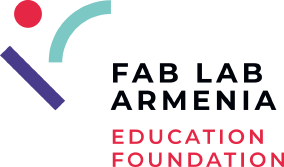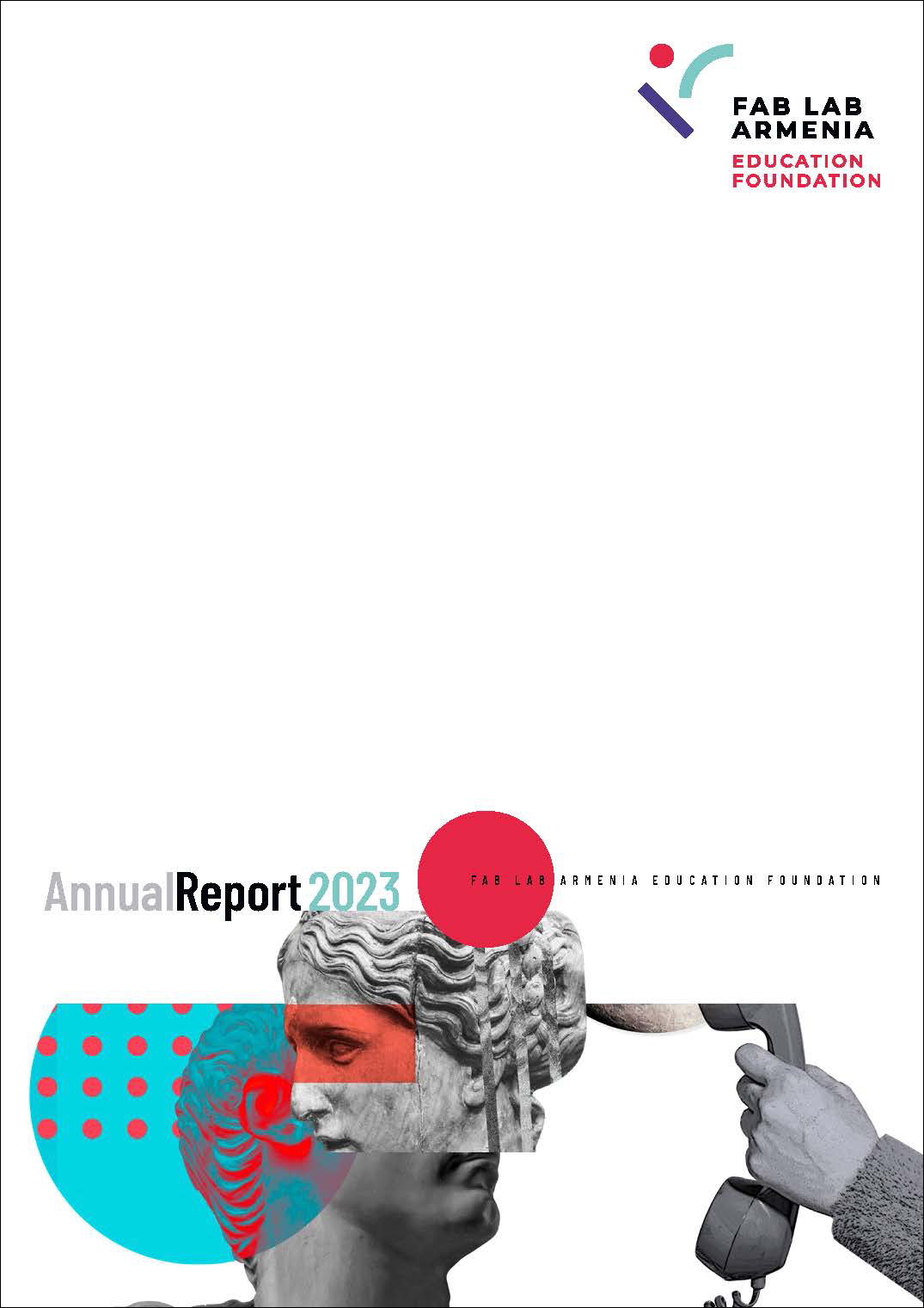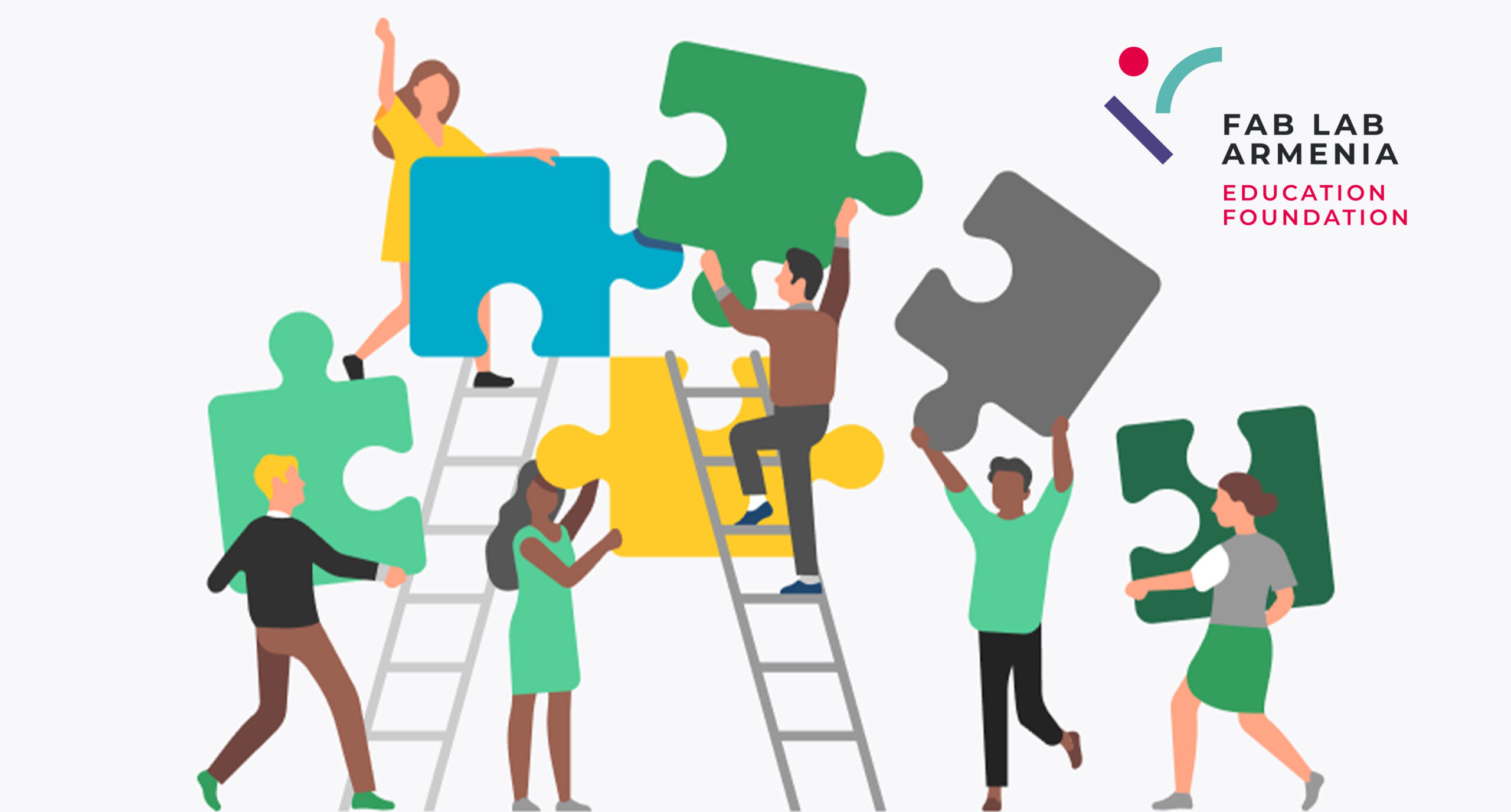
Unleashing Creativity and Mindfulness Through Breakthrough Brush
Discovering Breakthroughs: Fab Lab Armenia’s Inspiring Team-Building Experience with Vazken Kalayjian
On February 22, 2024, the dynamic team at Fab Lab Armenia came together for a truly transformative workshop led by Vazken Kalayjian.
Diverging from our usual focus on digital fabrication and technology, we delved into the captivating realm of Breakthrough Brush Chinese/Japanese calligraphy. For many of us, this was uncharted territory; we were neither fluent in Chinese nor experienced in Zen calligraphy.
Throughout the session, we unearthed the profound synergy between brushwork, mindfulness, creativity, and breakthrough moments. Guided by Kalayjian’s expertise, we embarked on an enriching journey of self-discovery, harnessing the power of the brush to tap into new wellsprings of inspiration, relaxation, and meditative reflection.
The Breakthrough Brush Workshop was a transformative exploration of the art of brushwork and calligraphy. Throughout our journey, we delved into various facets of this ancient craft, blending tradition with contemporary insights to foster personal and collective breakthroughs.
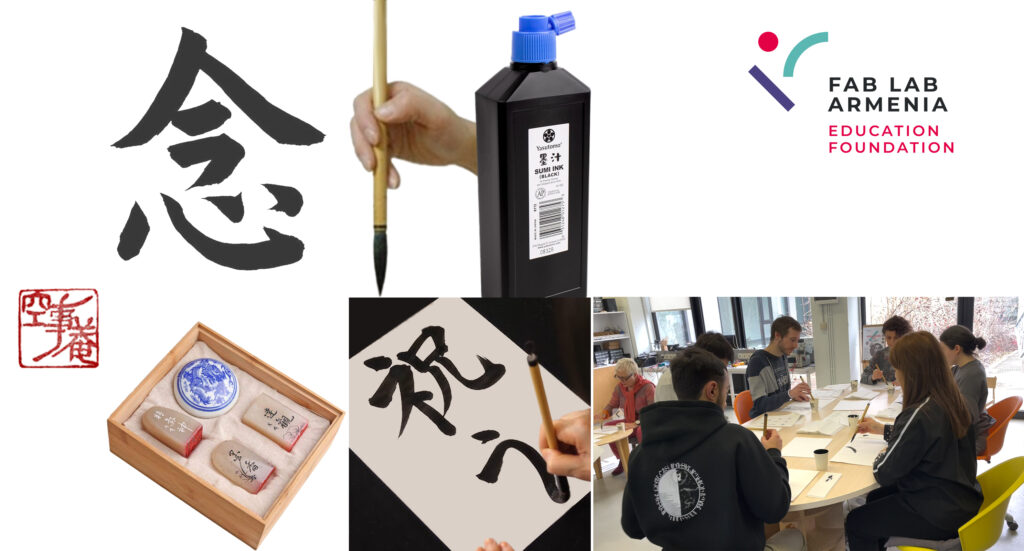
Breakthrough Brush:
- We embarked on a transformative journey where we explored breakthrough brushwork, delving into its essence.
- We unraveled the rich history and cultural significance behind the strokes of traditional Chinese and Japanese calligraphy.
- We familiarized ourselves with the essential tools for our artistic endeavors, from sumi ink to meticulously crafted brushes.
- We delved into time-honored methods that have shaped the art of calligraphy for centuries.
- We explored the symbolism and evolution of characters, focusing on the profound meaning behind the character “Human.”
- We discovered lessons of collaboration and cooperation through the graceful flight patterns of geese.
- We gained wisdom from the esteemed Kazuaki Tanahashi, a master of the craft, through the lens of Kalayjian’s mentorship.
- We cultivated a mindful approach to brushwork, incorporating breath, posture, and inner focus.
- We explored the applications of mindfulness in our artistic practice and daily lives.
- We embraced the power of simplicity and intention through the concept of “Ichi.”
- We built upon the foundation of mindfulness, stroke by stroke, with the principle of “Nen.”
- We appreciated the diverse interpretations of characters through the lens of different artists.
- We broke free from artistic constraints and explored new realms beyond the confines of the paper.
- We transitioned to larger canvases to facilitate individual breakthroughs and creative expansion.
- We collaborated on a team-sized canvas to share the concept of breakthrough and collective creativity.
- We embraced the philosophy of Wabi Sabi, finding beauty in imperfection and transience.
- We drew parallels between the flight patterns of geese and leadership dynamics within teams.
- We mined insights into collaboration, cooperation, and team unity from the natural world.
- We explored the spiritual frequencies of breakthrough and understood the power versus force paradigm.
- In the end, we embarked on a transformative journey where the brush met breakthrough and boundless creativity flourished.
Expressing Gratitude to our Mentor(s): Acknowledging Kazuaki Tanahashi’s Influence on Vazken Kalayjian
In our journey of growth and learning, Vazken Kalayjian extended heartfelt gratitude to his Mentor, Kazuaki Tanahashi, whose profound influence on Kalayjian has been pivotal. Tanahashi’s wisdom and expertise in Zen calligraphy have indelibly shaped Kalayjian’s artistic vision and approach. Through Tanahashi’s guidance, Kalayjian has garnered invaluable insights, allowing him to infuse his work with depth, authenticity, and spiritual resonance. Tanahashi’s legacy inspires and enriches Kalayjian’s practice and the broader community of artists and seekers.
Kalayjian said, “At the heart of our workshop lay the profound teachings inherited from Kazuaki Tanahashi, a revered luminary in the realm of Zen calligraphy. Tanahashi’s mastery of brush painting transcends mere technique, encapsulating the essence of Zen philosophy through his artistry.
“Tanahashi is a distinguished Japanese calligrapher, Zen teacher, author, and translator of Buddhist texts from Japanese and Chinese into English. Notably, he embarked on the translation of Shobogenzo in his early twenties, inspired by his encounter with Shunryu Suzuki in 1964. Reflecting on Suzuki’s book Zen Mind, Beginner’s Mind, Tanahashi remarked, “I could see it’s Shobogenzo in a very plain, simple language. “He has also collaborated with notable Zen teachers, including John Daido Loori, in authoring books on Zen Buddhism. Beyond his artistic and scholarly pursuits, Tanahashi is a fellow of the World Academy of Art and Science, an environmentalist, and a peace worker. Celebrating his 90th birthday on October 4, 2023, his work embodies the elegance of simplicity, impermanence, and harmony, urging observers to ponder the interconnectedness of existence.”
Through Tanahashi’s guidance, we gleaned profound insights into the transformative potential of brushwork as a conduit for spiritual expression and profound artistic revelation.
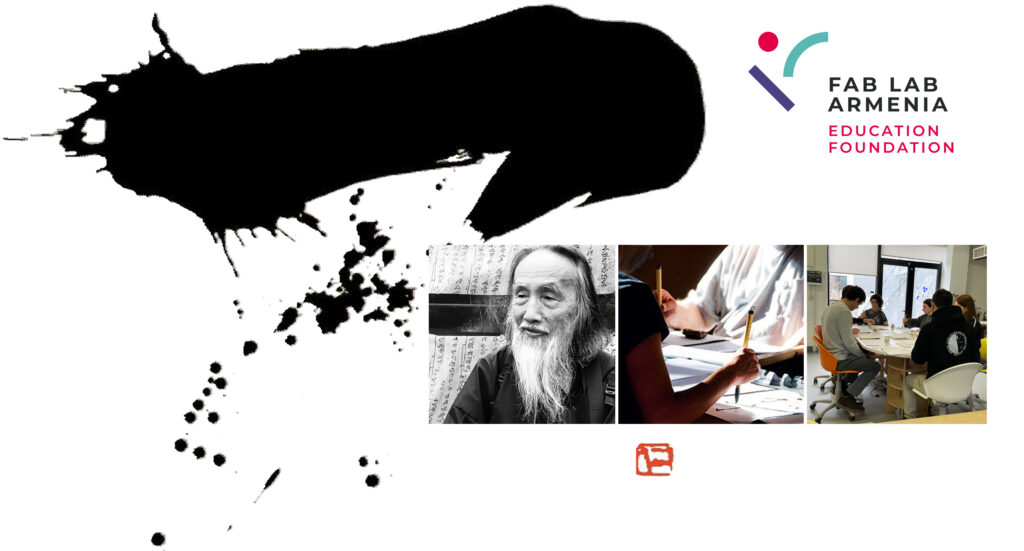
“In the Western tradition, masterpieces are often associated with struggle, suffering, and tragedy. In East Asia, creative people should be relaxed and enjoy their craft.”
–Kazuaki Tanahashi
East Meets West: Navigating Philosophical and Spiritual Crossroads for Humanity’s Future
Vazken Kalayjian explained that the philosophical and spiritual differences between the East and the West are deeply rooted in their respective cultural and historical backgrounds, spiritual practices, and approaches to understanding the self, the world, and existence itself.
“In the East, particularly in traditions like Taoism and Buddhism, as well as specific aspects of Hinduism, there is a strong emphasis on harmony, balance, and interconnectedness. The center of the body is often considered in the Hara or Dantien, located in the lower abdomen. Eastern disciplines focus on cultivating and storing energy in this center through meditation, qigong, tai chi, and yoga. Breathing techniques emphasize drawing air into the lower abdomen, or “belly breathing,” which promotes relaxation, vitality, groundedness, and direct connection to source, earth energy, heaven energy, and the elements without intermediaries. The goal is to develop physical strength, inner resilience, emotional balance, and spiritual insight.”
“Conversely, in the West, particularly in modern Western societies heavily influenced by scientific rationalism and materialism, there is often a tendency to prioritize intellectual knowledge and achievement. Education systems emphasize the accumulation of information and the development of analytical and critical thinking skills. Academic degrees, professional accomplishments, and material wealth often measure success. The focus tends to be on the head or the mind rather than the body or spirit. A Ph.D. from Harvard, MIT, or Oxford can confer significant prestige and privilege, symbolized by large mansions, luxury cars, private jets, substantial bank balances or investment portfolios, prestigious titles, and political power. However, such external markers of success may lack true wisdom and even harm others, the environment, and oneself.”
“This difference in emphasis between the East and the West reflects broader philosophical and cultural attitudes toward life and existence. The Eastern perspective views reality as dynamic and interconnected, emphasizing inner transformation and spiritual growth. On the other hand, the Western perspective often emphasizes individualism, progress, and external achievements.”
“Take the understanding of the East and the knowledge of the West—and then seek.”
–Gurdjieff
Vazken Kalayjian talked briefly about another one of his mentors, Gurdjieff, who said the evolution of humankind has entered an uncertain phase. Unless the “wisdom” of the East and the “energy” of the West unite and mutually feed each other, the world will inevitably collapse. His legacy of formidable teachings is one of the wisest and most adaptable for our contemporary lifestyle.
However, Vazken Kalayjian pointed out that neither perspective is inherently superior. Instead, he emphasized integrating the East’s wisdom with the West’s energy and dynamism. This integration, he believed, was essential for the survival and evolution of humanity. Without a harmonious balance between inner wisdom and outer action, humans risk becoming disconnected from themselves, each other, and the natural world, ultimately jeopardizing their existence.
Vazken Kalayjian added that Gurdjieff’s insight highlights the importance of transcending cultural, religious, and philosophical divides and recognizing the complementary nature of different perspectives. Only by embracing the yin and yang, the inner and outer, the spiritual and the practical, can humanity hope to navigate the complexities of the modern world and evolve consciously towards a more sustainable and harmonious future.
“Armenia’s Crucial Role as Bridge Between East and West: Fostering Cultural Fusion and Transmitting Wisdom”
–Vazken Kalayjian
Vazken Kalayjian stressed that Gurdjieff originated from Gyumri, Armenia, situated at a crossroads between the East and West, where various teachers, disciples, bards, shamans, artists, poets, and travelers passed through the Silk Road. They brought physical goods like spaghetti, dumplings, silk, porcelain, gunpowder, spices, paper, and a printing press and an exchange of ideas disseminated through ancient universities like Sanahin Monastery and other churches, which served as the internet of the Armenian people.
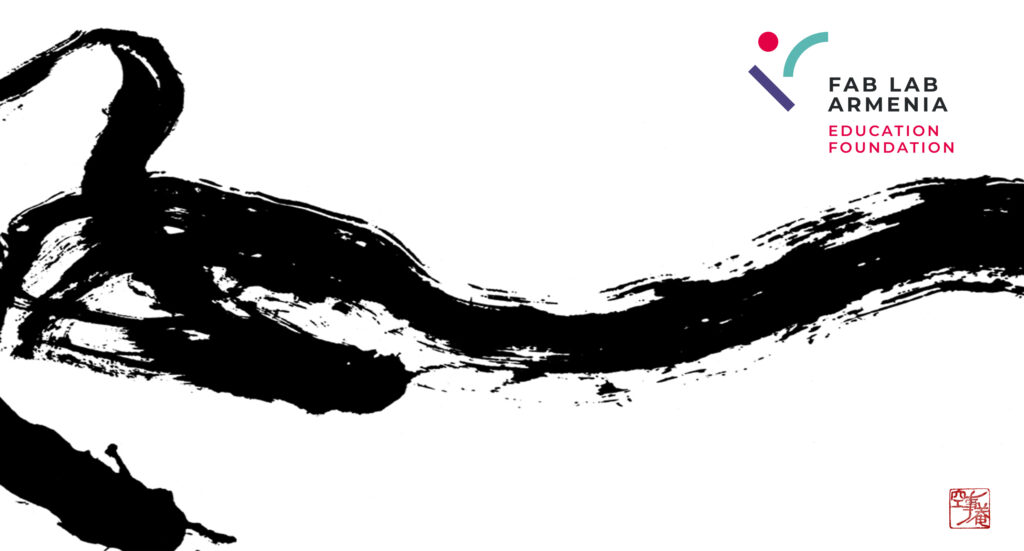
Embracing Tradition: The Art of Chinese Calligraphy
Central to our exploration was traditional Chinese calligraphy, a discipline rooted in mindfulness and meticulous attention to detail. From the careful preparation of Sumi ink to the deliberate execution of each brushstroke, we learned to approach the process with reverence and intentionality. By emptying our minds of distractions and focusing on the present moment, we cultivated a deep sense of concentration and flow essential to the art of calligraphy.
“Let go of suffering and tragedy, reserved for martyrs and victims. Embrace the present moment with your brush in hand, relax, and relish the act of leaving your mark on paper. There are no rewards or judgments, no classifications of good or bad, and certainly no PhD in Zen required.”
–Vazken Kalayjian
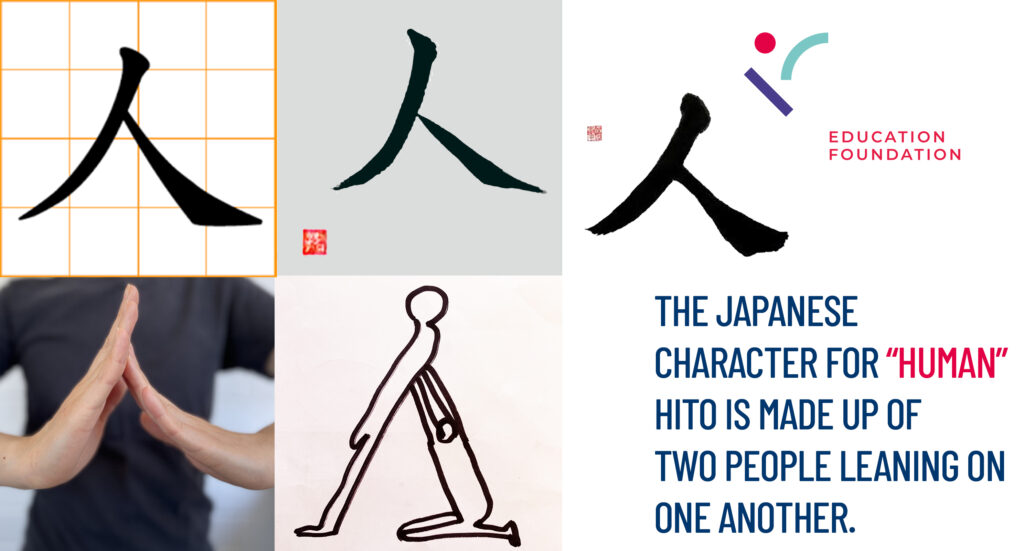
Vazken Kalayjian asked two team members to come up, one kneeling and the other standing, to fully trust and support each other. He explained how the origin of the Chinese symbol for “human” (人 rén) is deeply rooted in ancient Chinese culture and ideographic writing systems. The character has evolved over thousands of years, reflecting changes in its visual representation and cultural significance.
“What does it mean to be a human? We often forget that we are human beings and act like human doings.”
–Vazken Kalayjian
What Does It Mean to Be a Human
Vazken Kalayjian explained that the earliest forms of the Chinese character for “human” date back to the ancient oracle bone script used during the Shang Dynasty (c.1600–1046 BCE). In these early inscriptions, the character bore a resemblance to a stick figure, representing a simplistic depiction of a person standing upright and another person supporting the standing person.
Over time, as Chinese calligraphy and writing systems developed, the character of “ human” underwent various stylistic changes. During the Zhou Dynasty (c.1046–256 BCE), the character evolved into a more stylized form, with distinct strokes representing a person’s head, torso, and limbs.
The character’s meaning also expanded beyond its literal depiction of a human figure. In Chinese culture, “human” carries connotations of humanity, compassion, and interpersonal relationships. It symbolizes the essence of being human, encompassing qualities such as kindness, empathy, and social connection.
Throughout Chinese history, the character of “human” has been used in various contexts, from literature and philosophy to art and religious symbolism. It is a fundamental element of the Chinese language and cultural identity, representing the core values and aspirations of the Chinese people.
The “human “character in contemporary Chinese symbolizes shared humanity and moral values. It serves as a reminder of our common bonds and responsibilities towards one another, transcending linguistic and cultural barriers to convey universal truths about the human experience.
The Evolution of Expression: Japanese Brush Calligraphy
Under Kalayjian’s guidance, our team embarked on a journey of personal breakthroughs, gradually expanding our repertoire from minor brush marks to full symbols. As our brushwork evolved, so too did our awareness of posture, breath, and the subtle nuances of ink and paper. With each stroke, we tapped into mindfulness and creativity, embracing the spontaneity and joy inherent in Japanese brush calligraphy.
Cultivating Inner Peace: The Practice of Meditation
At the core of our journey, Kalayjian illuminated the practice of meditation and mindfulness, a potent tool for training your mind and nurturing inner peace and self-awareness. By attentively following the breath, we sharpen our focus, alleviate stress, and connect deeply with the present moment. Kalayjian suggested daily meditation (and prayer) became the cornerstone of our well-being, fostering emotional resilience and enriching our lives with clarity and inner harmony.
According to Kalayjian, being human is embracing a spectrum of emotions, thoughts, and sensations, forging connections with others, and navigating life’s complexities. It entails empathy, creativity, rationality, and self-awareness. Yet, amidst the whirlwind of daily life, we often lose touch with our humanity, fixating on tasks and achievements while neglecting our inner balance and deeper connections. When we function solely as “human doings,” prioritizing productivity over presence, we risk losing sight of our authentic selves. It’s vital to remember that being human transcends mere action; it involves cultivating presence, fostering genuine connections, and nurturing our inner essence.
We typically conceive of the five senses as:
- Sight: The visual system facilitates the ability to perceive light and interpret it as images.
- Hearing: The capacity to discern sound vibrations through the auditory system.
- Taste: The capability to detect and distinguish various flavors using taste buds on the tongue and within the mouth.
- Smell: The aptitude to recognize and differentiate diverse odors through olfactory receptors in the nose.
- Touch: The skill to perceive pressure, temperature, and texture via sensory receptors in the skin.
These senses enable us to engage with the world, supplying essential information for survival, communication, and enjoyment.
In Eastern philosophy, a sixth sense is acknowledged: thoughts. Managing these thoughts entails observing them without becoming sucked into them or identified by them, avoiding self-identification. Cultivating this skill requires mental training, a practice known as “placement meditation.”
The initial step is to establish a daily meditation practice, which can be as straightforward as focusing on the breath—inhaling and exhaling while observing thoughts and letting them go. Why? Consistent meditation fosters mindfulness, enhances attention, fortifies the mind, augments self-awareness, mitigates stress, sharpens focus, and nurtures emotional well-being. By ingraining meditation as a daily ritual, individuals develop the aptitude to navigate thoughts and emotions adeptly, fostering more profound inner peace, stability, and resilience in confronting life’s trials.
Harnessing the Power of Intention: Energy Follows Intent
We explored the concept of “energy follows intent,” recognizing the profound influence of our thoughts and intentions on the world around us. By aligning our intentions with positive energy and outcomes, we learned to manifest our deepest aspirations and aspirations into reality. Through conscious intentionality, we harnessed the transformative power of positive energy, shaping our experiences and interactions with purpose and clarity.
Embracing Acceptance: What You Resist Persists
In embracing the principle of “what you resist persists,” we learned to release the grip of resistance and surrender to the natural flow of life. By cultivating acceptance and non-attachment, we liberated ourselves from the cycle of suffering and found peace amidst life’s challenges. Through the practice of Taoist philosophy, we embraced the wisdom of letting go, allowing events to unfold naturally and harmoniously.
Unlocking Synchronicity: A Dance with the Universe
We delved into the concept of synchronicity, recognizing the interconnectedness of events and experiences in our lives. We tapped into a more profound sense of purpose and connection by embracing meaningful coincidences and aligning ourselves with the universe’s rhythm. Through synchronicity, we discovered the beauty of being in sync with the flow of life, unlocking new levels of creativity and insight.
The Power of Mind Training: Observing the Landscape of Consciousness
Central to our journey was the cultivation of the observer self, a state of mindful awareness that transcends the ceaseless chatter of the mind. By training our minds to observe thoughts with detachment and non-attachment, we freed ourselves from the grip of ego and discovered a profound sense of inner peace. Through mindfulness and meditation, we cultivated a deeper understanding of the nature of consciousness, unlocking the door to profound self-discovery and transformation.

Elevating Humanity: The Ripple Effect of Positive Energy and Consciousness
Amidst the overwhelming tide of global events, including conflicts and environmental upheavals, the power of individual positivity resonates as a transformative force akin to a ripple effect.
The concept is grounded in the understanding that each person’s positive energy, anchored by a loving heart, can reverberate outward, affecting countless others. This principle is further underscored by the fascinating dynamics of emotional frequencies, as elucidated in the Power vs. Force paradigm.
According to this paradigm, emotions carry distinct vibrational frequencies, ranging from the lower depths of shame and guilt to the enlightened heights of joy and peace. Each emotional state corresponds to a specific hertz frequency rate, influencing our interactions and experiences.
Furthermore, the paradigm reveals a profound insight into the potential impact of individual consciousness levels. Single individuals operating at higher levels of consciousness can counterbalance thousands—even millions—of individuals vibrating at lower frequencies. This suggests that personal growth and spiritual elevation powerfully shape collective consciousness and societal dynamics.
For example, an individual vibrating at level 600 Hz can counterbalance a staggering 10 million individuals below level 200 Hz. Moreover, twelve individuals operating at level 700 Hz collectively hold the transformative potential equivalent to an enlightened being, such as Buddha or Jesus, resonating at level 1,000 Hz.
Understanding consciousness levels also sheds light on individuals’ susceptibility to external influences. Those operating below level 200 Hz are more prone to manipulation and negativity, particularly when subjected to hate speeches or divisive rhetoric by authoritarian figures.
In essence, the concept of the ripple effect, coupled with the Power vs. Force paradigm, underscores the profound interconnectedness of human consciousness and the transformative power of individual positivity. By elevating our consciousness and radiating love and positivity, we contribute to the collective upliftment of humanity, transcending barriers and fostering a more harmonious world.
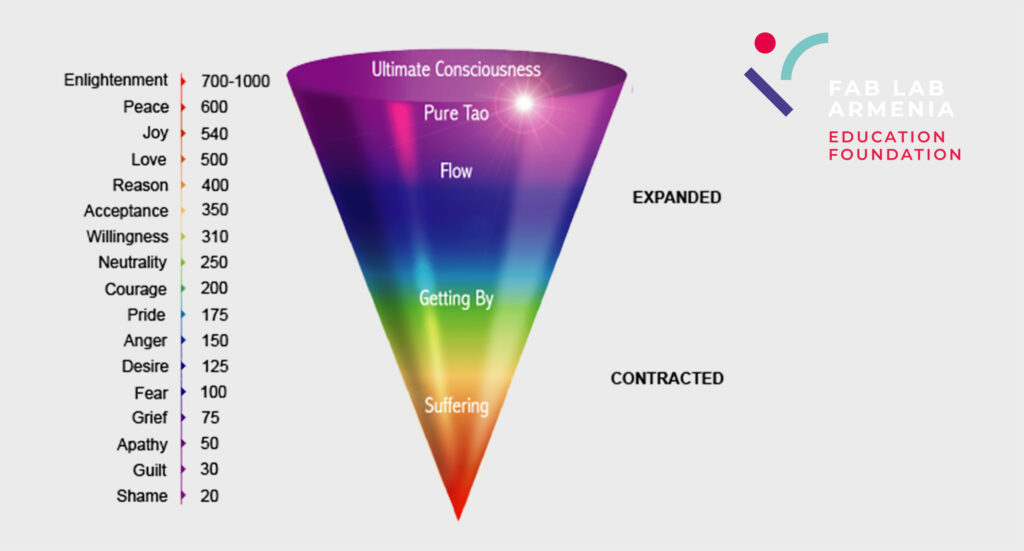
Principles for Action: Four Commonplace Truths By Kazuaki Tanahashi
Kalayjian shared the four commonplace truths as guiding principles for action, recognizing the power of communal vision, sustained effort, and shared responsibility in fostering positive change. Through collaboration and collective action, we affirmed our capacity to make a difference and shape a brighter future for ourselves and others.
- No situation is impossible to change.
- A communal vision, outstanding strategy, and sustained effort can bring positive changes.
- Everyone can help make a difference.
- No one is free of responsibility.
Ten Laws of Breakthrough By Kazuaki Tanahashi
According to Kalayjian, а breakthrough is a sudden and overwhelming unfolding of freedom from long-held limitations. Breakthrough makes what seems impossible possible.
- Breakthrough may or may not occur. The result is unpredictable, and how it happens is mysterious. All we can do is work toward a breakthrough.
- Some breakthroughs are life-affirming, and others destructive.
- The chance for breakthrough increases when the objective and general process are clearly stated.
- The chance for breakthrough increases when the blocks are identified.
- The smaller the objective is, the larger the chance for a breakthrough.
- An effective, intense, continuous effort builds a foundation for breakthrough.
- The more forces are combined, the larger the chance for a breakthrough.
- The greater the objective is, the easier it is to bring together forces for a breakthrough.
- The chance for breakthroughs increases when more attention is directed to the process than the goal.
- Nonattachment is a crucial element for a breakthrough.
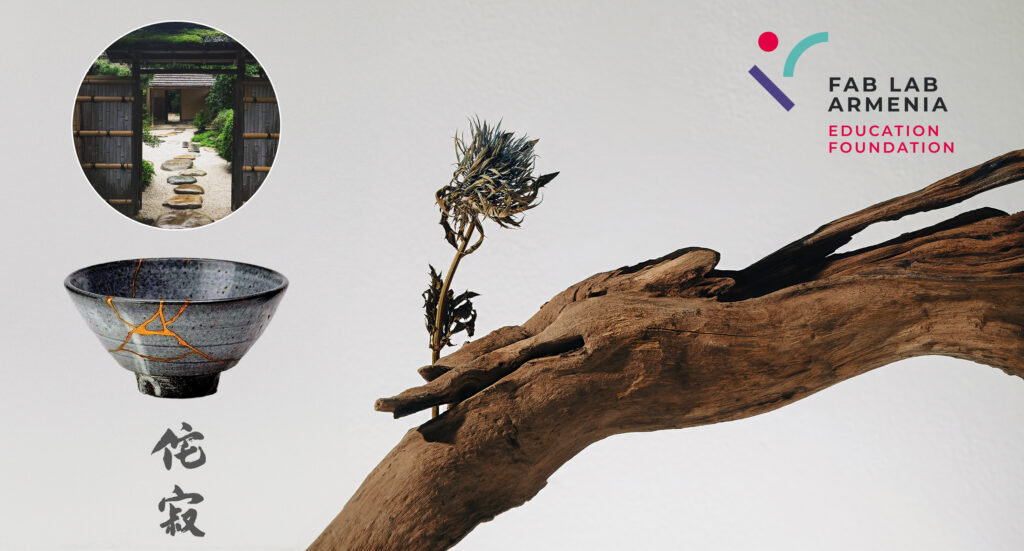
The Philosophy of Wabi-Sabi
This Japanese worldview is centered around accepting imperfection, transience, and the beauty of impermanence. Rooted in Zen Buddhism, wabi-sabi celebrates the simplicity, authenticity, and inherent flaws in nature and everyday life. At its core, wabi-sabi encourages individuals to embrace the beauty of imperfection, finding solace and appreciation in the ephemeral nature of existence.
Key Principles of Wabi-Sabi:
- Imperfection:
Wabi-sabi celebrates the beauty of imperfection, recognizing that flaws and irregularities are an integral part of life’s natural cycle. Rather than seeking perfection, wabi-sabi encourages accepting life’s imperfections and finding beauty in asymmetry, roughness, and simplicity.
- Transience:
Central to wabi-sabi is accepting impermanence and the fleeting nature of existence. This principle emphasizes the inevitability of change and decay, encouraging individuals to appreciate the ephemeral beauty of the present moment.
- Simplicity:
Wabi-sabi values simplicity and austerity, eschewing excess and extravagance in favor of understated elegance. By stripping away unnecessary adornments and distractions, wabi-sabi invites individuals to find beauty in life’s unadorned and essential aspects.
- Naturalness:
Embracing the natural world is fundamental to wabi-sabi philosophy. It celebrates the inherent beauty of natural materials, textures, and forms, fostering a deep connection to the environment and an appreciation for the rhythms of nature.
- Acceptance:
Wabi-sabi encourages acceptance of life’s inevitable ups and downs, embracing joy and sorrow as essential aspects of the human experience. Individuals can find peace and contentment amidst life’s uncertainties by cultivating a mindset of acceptance and non-attachment.
- Appreciation of the Moment:
Wabi-sabi emphasizes the importance of mindfulness and presence, urging individuals to savor the richness of each moment. By fully engaging with the present moment, individuals can cultivate a more profound sense of gratitude and awareness, finding beauty in the ordinary and mundane.
- Modesty:
Humility and modesty are valued virtues in the wabi-sabi philosophy. Rather than seeking recognition or acclaim, wabi-sabi encourages individuals to find fulfillment in simplicity and authenticity, embracing a sense of humility in both success and failure.
Overall, the philosophy of wabi-sabi offers a profound perspective on life, urging individuals to find beauty, meaning, and contentment in existence’s imperfect, impermanent, and transient nature. By embracing the principles of wabi-sabi, individuals can cultivate a more profound sense of peace, harmony, and appreciation for the richness of life’s unfolding journey.
The Power of Collaboration: Learning from Why Geese Fly Along in a V-formation
Next time you see a flock of geese flying along in a V-formation, consider what science has discovered about how they fly.
As each bird flaps its wings, it uplifts the bird immediately following. The flock traveling together adds seventeen percent greater efficiency than if each traveled alone.
When the lead goose gets tired, it changes position, allowing another goose to take its place.
Geese flying in the back honk at those up front, encouraging them to maintain speed. When a goose gets sick and must fall out of formation, two other geese fall out for help and protection.
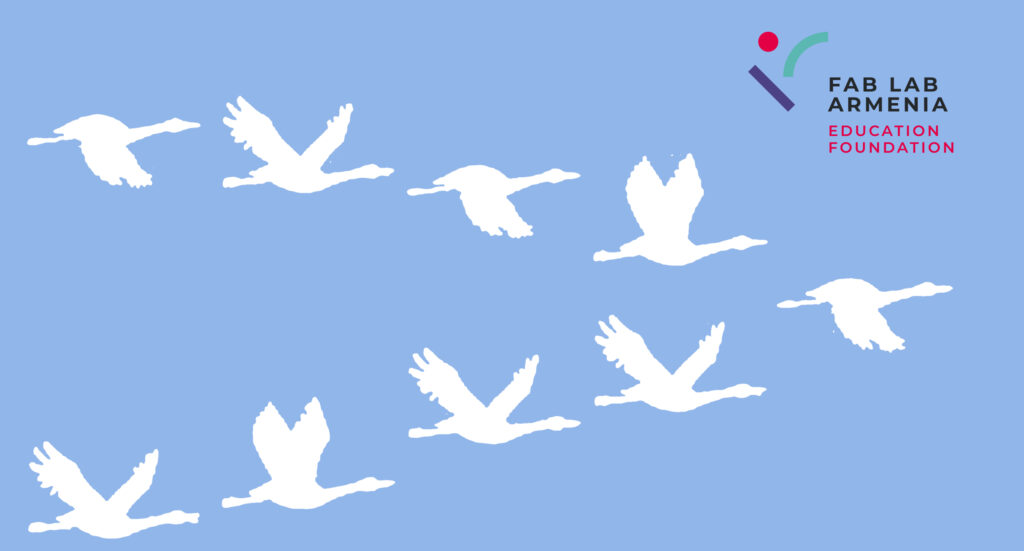
“Together, you will soar to new heights on the thrust of one another.”
–Vazken Kalayjian
The phenomenon of geese flying in a V formation offers several valuable lessons that can be applied to teamwork, leadership, and collaboration: Discover the power of teamwork and collaboration with geese flying in a V-formation!
Those who share a common direction get there faster and easier
- Shared Leadership: Geese take turns leading the flock, rotating the position at the front. This shared leadership ensures that leading is not solely on one individual, promoting teamwork and collaboration.
- Efficiency: Flying in a V formation reduces wind resistance for all geese except the lead goose, enabling them to conserve energy and fly more efficiently. This teaches us the importance of finding ways to streamline processes and work together to achieve common goals.
- Support and Cooperation: Geese honk will encourage those at the front to maintain speed, fostering a sense of support and cooperation within the group. This demonstrates the importance of communication and encouragement in achieving collective success.
- Resilience and Adaptability: Geese adjust their formation in response to changes in wind patterns and other environmental factors, showcasing their ability to adapt and remain resilient in the face of challenges. This highlights the importance of flexibility and adaptability in navigating obstacles and achieving objectives.
- Community and Mutual Benefit: Geese fly close to one another, benefiting from the uplift generated by the flapping wings of those ahead. This emphasizes the importance of community and mutual support in achieving common goals, as each member contributes to the group’s overall success.
Unlocking Collective Potential: Lessons from Geese on Teamwork and Empowerment
Drawing inspiration from the symbiotic flight pattern of geese, we’ve unearthed the transformative potential of teamwork and mutual support. Just as geese fly in a V formation to uplift and empower one another, our collective efforts in the workshop fostered a spirit of fellowship and encouragement. We transcended individual limitations through collaboration and shared creativity, reaching new heights of artistic expression and personal growth. Overall, the lessons from geese flying in a V formation underscore the significance of collaboration, communication, adaptability, and shared leadership in achieving collective success. This is a lesson in collaboration and distributed leadership.
How Do Geese Flying in V Formation Apply to Our Team at Fab Lab Armenia?
This is the age of collaboration, and as you welcome new talent onboard. Have the confidence and the mechanism to have a fruitful collaboration. With your deep roots in this industry, our goal is to create significant value for Fab Lab Armenia so it can rightfully secure its place as a top lab globally, poised for expansion, prosperity, and reaching all its goals. As you learn fast, grow faster, and develop the expertise to navigate the complexities of this swiftly changing world and leapfrog into the future.
What is expected from team members:
- A deep understanding of the brand, its vision, mission, values, strategy, and course of action.
- You are always learning and growing; if you stay still, you are already falling behind, and you become obsolete.
- Many are here to provide you with guidance and support, but you have to be open to first humility to admit you don’t know something and eager enough to find the best resources available to get the help you need. Always ask, and there is nothing “almost” in not knowing.
- In moments of unforeseen challenges, value collective brainstorming and collaborative problem-solving.
- You are at a critical, delicate stage that demands a unified approach to succeed.
Your Role Involves:
- Managing operations with a strategic mindset.
- Implementing plans effectively.
- Addressing unexpected issues promptly.
- Collaborating closely to make key decisions together.
Collaboration. Leadership Styles
The Connected Leader
Creating agile organizations requires a new breed of leadership – the connected leader. In Emmanuel Gobillot’s book “The Connected Leader: Creating Agile Organizations for People, Performance, and Profit,” he delves into the essence of this leadership style and its impact on modern businesses. This essay will explore the fundamental concepts of the connected leader, management theories, lessons, characteristics, suggested practices, advice, and a conclusion.
In today’s fast-paced and interconnected business environment, traditional leadership models fall short in fostering adaptability and innovation. The concept of the connected leader emerges as a response to the need for leaders who can navigate complexity, inspire collaboration, and drive sustainable growth. Emmanuel Gobillot’s work shows how connected leadership transforms organizations to thrive in the digital age.
Key Management Theories:
Gobillot emphasizes the importance of building relationships within and outside the organization as a core component of connected leadership. He highlights the significance of emotional intelligence, empathy, and active listening in building trust and driving engagement. The book also explores the Role of transparency, authenticity, and alignment with organizational values as critical elements in leading agile organizations.
Lessons and Takeaways:
One key lesson from “The Connected Leader” is the need for leaders to embrace vulnerability and humility, fostering a culture of psychological safety where diverse perspectives are valued. The book underscores the importance of fostering a growth mindset, encouraging experimentation, and learning from failure as drivers of innovation and continuous improvement.
Characteristics of the Connected Leader:
Connected leaders exhibit strong communication skills, are adept at building networks, and demonstrate a deep understanding of their team members’ strengths and motivations. They prioritize collaboration, empower their teams to make decisions and champion a shared sense of purpose to drive organizational success.
Key Practices Suggested:
Gobillot suggests that connected leaders should prioritize coaching and mentoring, providing guidance and support to develop their team members’ skills and capabilities. They should also focus on creating a culture of psychological safety, where individuals feel comfortable taking risks and sharing their ideas without fear of judgment.
Advice and To-Dos:
– Foster open and honest communication within your team.
– Invest in developing solid relationships with stakeholders.
– Embrace diversity and inclusion as drivers of innovation.
– Continuously seek feedback and be open to learning and adapting.
– Lead by example and embody the values you wish to instill in your organization.
“The Connected Leader” by Emmanuel Gobillot, published in 2007, offers valuable insights into leadership’s essential qualities and practices in the digital age. By embodying the characteristics of connected leadership, leaders can create agile organizations that thrive on collaboration, innovation, and adaptability. As businesses navigate an increasingly complex and competitive landscape, embracing the principles of connected leadership can drive sustainable growth and success.
Conclusion
Embracing the Breakthrough Brush, Wabi-Sabi Wisdom, and Many Other Lessons
As we conclude our journey into the world of brushwork, Kalayjian shares another profound philosophy of wabi-sabi, and we find ourselves enriched with insights, inspiration, and a deeper understanding of life’s inherent beauty. Through the guidance of Vazken Kalayjian and the timeless wisdom of Zen masters like Kazuaki Tanahashi, we have unlocked new dimensions of creativity, mindfulness, and inner peace.
Kalayjian said in the words of Lao Tzu, “Nature does not hurry, yet everything is accomplished.” This sentiment encapsulates the essence of wabi-sabi, reminding us to embrace the natural rhythm of life and find solace in the simplicity of each moment. As we cultivate mindfulness and presence in our brushwork and daily lives, we discover that imperfection is not a flaw to be corrected but a source of profound beauty and authenticity.
Through collaboration, meditation, and the power of intention, we harness the transformative potential of brushwork to transcend limitations and tap into our true creative essence. As geese fly in formation, supporting one another on their journey, so do we find strength and inspiration in community and shared vision.
In the words of Zen master Shunryu Suzuki Roshi: “In the beginner’s mind, there are many possibilities, but in the expert’s, there are few.” Let us cultivate a beginner’s mind, open to the endless possibilities that await us on our creative journey. Knowing that the wisdom we have gained will continue to inspire and guide us on our path.
“In the beginner’s mind, there are many possibilities, but in the expert’s, there are few.”
– Shunryu Suzuki
#breakthrough #chinesecalligraphy #japanesecalligraphy #leadership #connectedleader #inspiration #mindfulness #creativity #innerpeace #wabisabi #authenticity #transformation #gratitude #endlesspossibilities
